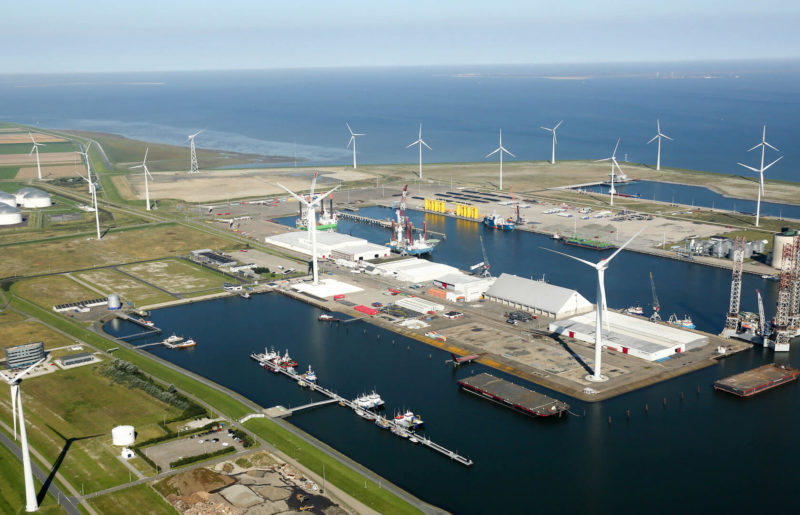A once modest seaport in the northern Netherlands has become an energy hub for the nation, with gas- and coal-fired power plants, onshore wind power, and massive turbine parts shipping out to offshore wind energy farms in the North Sea.
Think of the oil service industry’s Port Fourchon, La., but with windmills dotting the skyline.
At the mouth of the Eems estuary in the northern Netherlands, Eemshaven was planned as a deepwater port and economic development center in the 1970s. After decades of fitful growth, it hit a stride serving offshore wind energy ventures in the North Sea.
Since then the port and its tenant companies have played a role in building 16 wind projects. During 2018 Eemshaven was involved in construction of five wind arrays in the German part of the North Sea, potentially a record for the number of projects out of a single port in a year, according to operators Groningen Seaports.
But it is not a one-stop shop, said Erik Bertholet, business manager for logistics and offshore wind with Groningen.
“We collaborate with other ports,” Bertholet said at a panel discussion at the International Partnering Forum 2019 wind energy conference in New York City. “The people installing wind farms like to spread their risks.”
That requires dependable logistics, coordinating delivery of components, and matching construction timelines to ports and regional weather windows. European ports like Eemshaven and Bremerhaven in Germany have to space to store wind power components — including tower sections, rotor blades, and many miles of cables — in coexistence with their other businesses.
There are no bridges or other infrastructure barriers to Eemshaven’s four basins. Turbine components and construction vessels set out, and crewboats come back in on Wednesdays for crew change, all under turbines turning in the sea breeze to generate power and test new machines for the industry.
There is nothing like it in the U.S. and adapting the East Coast port infrastructure for offshore wind development here is a real challenge, experts said. Ports with existing business lines already taking up their space are reluctant to commit the land needed for staging wind turbines, said Jay Borkland, senior engineering manager for Lloyd’s Register Energy Americas, Boston, who has closely analyzed the available port capacity.
“There are not any 800- to 1,000-acre sites. Any of the large sites that exist are being used for car shipping, containers or aggregate,” said Borkland.
Massachusetts invested heavily in the New Bedford Marine Commercial Terminal, a combination of pollution remediation and economic development that used contaminated sediment from the harbor to build a 21-acre hardened facility strong enough to handle the weight of wind machines.
But Massachusetts and neighboring Rhode Island are already looking for ways to expand their shoreside potential, as the wind industry looks ahead to even bigger turbines coming online in the 2020s.
Judging from recent American Wind Energy Association conferences, “there’s a kind of beauty contest going on here on the East Coast of the United States” as states vie for wind developers to choose them as their home base in the market, said Arjen Schutten, director of Holland Home of Wind Energy, the Netherlands industry’s export association.
But it’s unlikely any U.S. state could build the Port Fourchon of offshore wind power on the East Coast, considering deep layers of coastal land use and wetlands protection laws that have expanded since the 1970s — largely in response to political opposition to Atlantic oil and gas drilling.
Industry observers said the more successful evolution will require states to work together, networking to capitalize on their ports’ strengths and capabilities.
One way may be for Congress to authorize “national offshore wind energy zones” to provide incentives for states to work together, suggested Paul Vigeant, managing director of the New Bedford Wind Energy Center.
“If we think that we can capture everything, we’re fooling ourselves,” he said.




